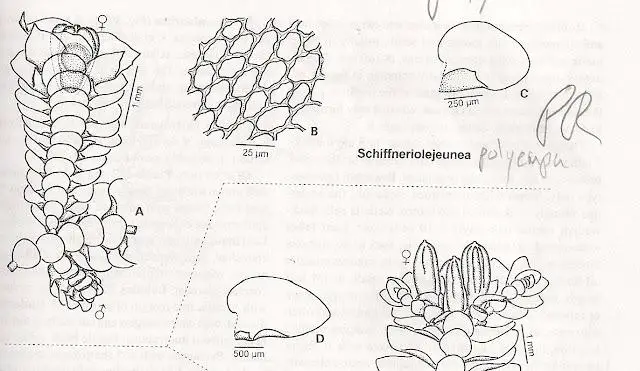Schiffneriolejeunea tumida: Exploring the Intricate World of Lejeuneaceae Mosses
Affiliate Disclaimer: As an affiliate, we may earn a small commission when you make a purchase from any of the links on this page at no additional cost to you!

Figura-8-a-b-Schiffneriolejeunea-amazonica-a-hbito-b-fildio-em-vista-ventral-c-f.png from: https://www.researchgate.net/figure/Figura-8-a-b-Schiffneriolejeunea-amazonica-a-hbito-b-fildio-em-vista-ventral-c-f_fig7_327378240

42-Schiffneriolejeunea-polycarpa-all-from-Kornochalert-745-31-Ventral-part-of_Q640.jpg from: https://www.researchgate.net/figure/42-Schiffneriolejeunea-polycarpa-all-from-Kornochalert-745-31-Ventral-part-of_fig4_272708082
Schiffneriolejeunea tumida: The Fascinating Moss of the Lejeuneaceae Family
Introduction
Have you ever stopped to admire the tiny, intricate world of mosses? One particularly captivating species is

Acrolejeunea-arcuata-Nees-Grolle-Gradst-A-Part-of-plant-E-Leaf-L-Gynoecium-and.png from: https://www.researchgate.net/figure/Acrolejeunea-arcuata-Nees-Grolle-Gradst-A-Part-of-plant-E-Leaf-L-Gynoecium-and_fig39_357780316
Schiffneriolejeunea tumida (Nees) Gradst., a member of the Lejeuneaceae family. In this blog post, we’ll dive into the fascinating details of this diminutive but important plant.
Background
Schiffneriolejeunea tumida is a species of leafy liverwort, which are non-vascular plants in the division Marchantiophyta, class Jungermanniopsida. The Lejeuneaceae family contains over 1000 species found worldwide. The genus name Schiffneriolejeunea honors Victor Schiffner, an Austrian bryologist.
Morphology and Identification
S. tumida forms small, light green mats on tree bark, rocks, and soil. Its

VC11-sphagnum-subsecundum-m22618.jpg from: https://www.britishbryologicalsociety.org.uk/learning/species-finder/sphagnum-subsecundum/
leaves are ovate with rounded tips and measure only 0.5-1 mm long. The underleaves are much smaller and bifid (split in two at the tip). Oil bodies, organelles unique to liverworts, are present in the leaf cells. The species is autoicous, meaning both male and female reproductive structures are on the same plant.
Global Distribution and Habitat
This species has a pantropical distribution, found in tropical regions of the Americas, Africa, and Asia. It grows in humid forests from sea level to 2000 m elevation, often in association with other bryophytes and on various substrates like tree trunks, branches, leaves, rocks, and soil banks.
Ecological Roles and Adaptations
As with other bryophytes, S. tumida plays important ecological roles in its habitats:
- Helps retain moisture and prevent erosion
- Provides shelter for micro-organisms and small invertebrates
- Participates in nutrient cycling
- Bio-indicator of air quality and habitat integrity
The species has several adaptations for its epiphytic lifestyle:
- Small size for growing in limited spaces
- Rhizoids and lobules for attachment and water retention
- Tolerance of periodic drying and low nutrient availability

Afroriccardia-comosa-Steph-Reeb-Gradst-comb-nov-Population-close-to-sample.png from: https://www.researchgate.net/figure/Afroriccardia-comosa-Steph-Reeb-Gradst-comb-nov-Population-close-to-sample_fig2_313494245

GS011143_2.jpg from: https://diatoms.org/species/cymbella_tumida

Population-of-Riccardia-verticillata-Gradst-Reeb_Q640.jpg from: https://www.researchgate.net/figure/Population-of-Riccardia-verticillata-Gradst-Reeb_fig2_337811585

spaanse-moss-tillandsia-usneoides-met-slender-stemas-line-gebruik-als-tuindecoratie-door-hangen-op-de-boom-plakken-steeltjes-244042095.jpg from: https://nl.dreamstime.com/spaanse-moss-tillandsia-usneoides-met-slender-stemas-line-gebruik-als-tuindecoratie-door-hangen-op-de-boom-plakken-steeltjes-image244042095
| Characteristic | Description |
|---|---|
| Leaf shape | Ovate with rounded tips |
| Leaf size | 0.5-1 mm long |
| Underleaves | Bifid, much smaller than leaves |
| Oil bodies | Present in leaf cells |
| Reproduction | Autoicous |
Conclusion

Metzgeria-holzii-A-C-Habit-in-ventral-view-showing-sacs-B-Portion-of-thallus-in_Q320.jpg from: https://www.researchgate.net/figure/Metzgeria-holzii-A-C-Habit-in-ventral-view-showing-sacs-B-Portion-of-thallus-in_fig2_320927863
Schiffneriolejeunea tumida may be small, but it is a prime example of the incredible diversity and adaptations found in the bryophyte world. Next time you’re in a tropical forest, take a closer look – you might just spot this marvelous moss! What other tiny wonders are waiting to be discovered?

SCHIFFRIOLEJEUNEA.jpg from: https://plantasdepuertorico.blogspot.com/2017/02/hepaticas-lobadas-lejeunaceae_65.html
